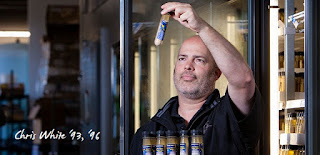Yeast. California was at the beginning of it all.
Long has the state been synonymous with American craft beer and home to many movements in beer.
San Diego was the city in the centre of this burgeoning scene.
Breweries like Alesmith, Stone and Ballast Point were some of the first to step into this brave new beer world.
American craft brewing is mostly associated with hop-forward IPA’s and malty german-style lagers. However, it’s yeast which is keeping San Diego at the forefront in the future of brewing.
Chris White studied biochemistry at the San Diego campus of California University, around the time of this revolution.
He signed up for a course on home-brewing ran by Yuseff Cherney. The two became friends and, along with Jack White – no relation, soon began home-brewing.
Yuseff was developing great recipes and Chris his first yeast strains for brewing.
Jack opened a home-brewing supply shop, Home Brew Mart and employed Jack. The premises soon became the base for Ballast Point and Jack their head-brewer.
With his passion for brewing and education in bio-chemistry, Chris went on to form White Labs in 1995, providing yeast strains to Ballast Point, then the rest of California and eventually the world.
Laboratories like White Labs are crucial to brewers, they provide the hundreds of different varieties needed for beers, create unique in-house strains specifically for one brewery and cultivate and develop new strains.
White labs continued to expand, now with operations across America, product distribution in Hong Kong and a lab within the War Pigs complex in Copenhagen, a collaborative brew-pub ran by Danish brewers Mikkeller and American brewery 3 Floyds.
The original White Lab’s in San Diego features a 20 barrel brewhouse producing yeast centric beers to tasting rooms at White Labs in America.
Along with several genomics groups, White Labs have spent three years sequencing the genetic information of 157 strains of ale brewing yeast Saccharomyces cerevisiae.
Formally used for baking, its ancestors have been used for millennia to ferment sugars into alcohol and each unique strains has been developed for a specific style and application.
White recently told Good Beer Hunting, that although the research had no end product in mind, there are many applications to improving brewing science.
This type of study has never been done before, the genome for Saccharomyces C. was sequenced in 1996 but that was not a specific brewing strain. The report, published in September last year, has pieced together Saccharomyces’ vague history and relationship to brewing. Firming up folk lore and speculation with details about it’s domestication for brewing from its wild ancestry.
When looking at the genetic history of each strains genome, scientists documented a common change around the 17th century. This coincides with the belief that it was around this time humans began to cultivate and reuse yeast for mass beer production.
Analysis confirms that there is a genetic difference between Saccharomyces cerevisiae and other yeasts, with a documented difference in the genomes of each of the studied strains.
This includes evidence of a variation between bottom fermenting lager yeasts and top fermenting ale yeasts, confirming that there is a true genetic difference behind their behaviours.
The study shows convergent evolution of strains from different parts of the world, developing the same properties needed for brewing during domestication, despite being entirely unrelated strains.
This understanding of the genetics of yeast can lead to advances in the microbes usage for brewing, with a further knowledge of exactly why and how yeast behaves like it does.
Better analytical tools could be developed, meaning brewing yeast could be tested for contamination before being used, along with improving selection of strains which are highly productive, based upon measurements such as stress tolerance or sugar utilisation, and useful in large operations.
Research has begun on the yeasts phenols and phenotypes. These molecules influence beers aroma and taste, flavours which are most recognisable in the unique taste of Belgian beers.
It is theorised that these phenols could be exaggerated or removed, controlling the resulting aromas and taste and picking out desirable phenotypes or removing those that cause off tastes.
White labs and their contemporaries aim to continue their research into lambic and wild yeasts like Brettanomyces and other strains not currently used in brewing.
With development set to continue, unlocking the full potential of yeast in brewing could change beer forever.
Who knows, in years to come we could be talking about yeast strains with particularly desirable characteristics in the same regard as hop varieties today.
MP

